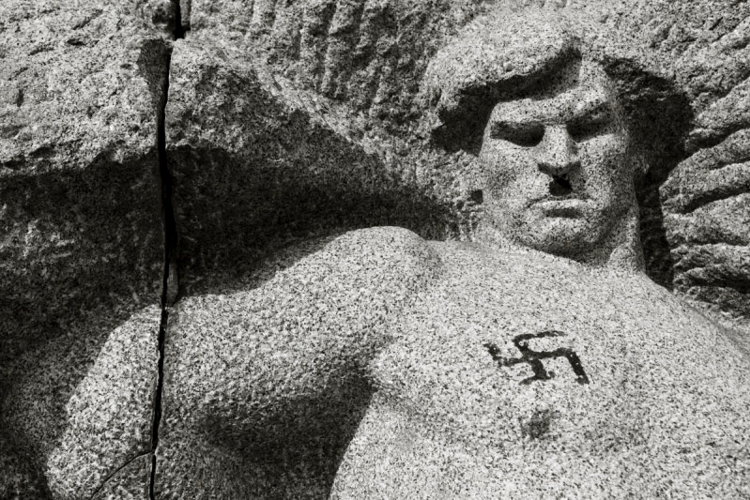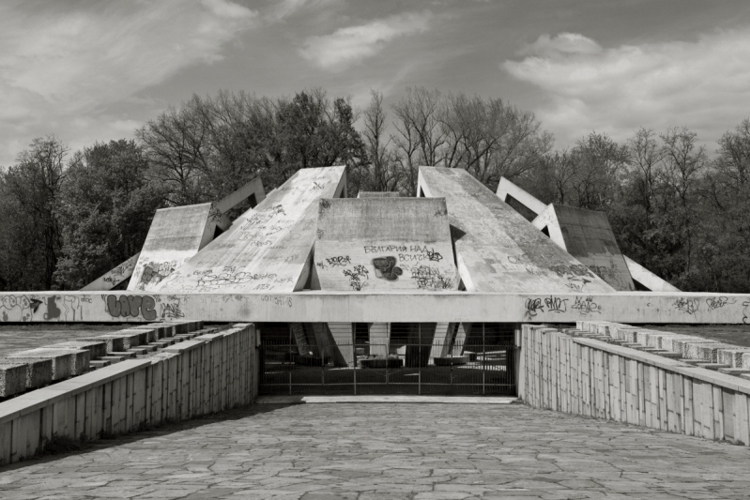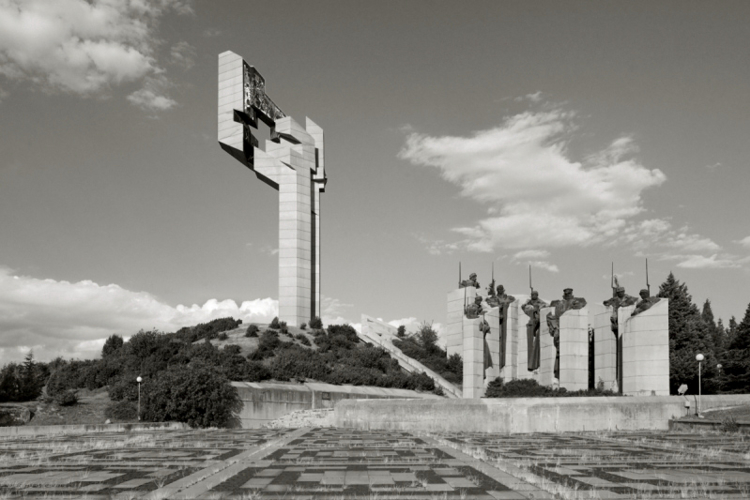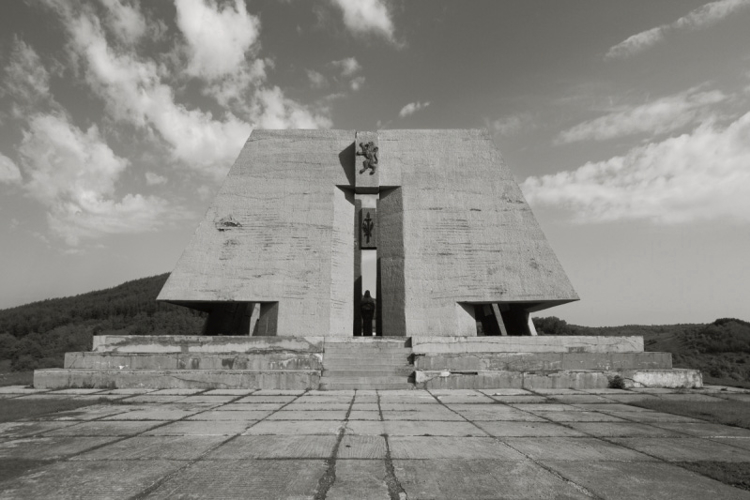-
-
Monument to the Soviet Army, Burgas ,1954The Monument to the Soviet Army in Burgas, is located in the center of town, where the citizens of Burgas welcomed the Soviet Army in 1944. The monument was officially unveiled at 9 a.m. on 9 May 1954 to mark the ninth anniversary of the defeat of Nazi Germany. The political changes of 1989 prompted a heated public discussion of the monument’s future. Eventually, in 1992, the presidents of Bulgaria and Russia signed a Treaty of Friendship and Cooperation which protected it from demolition.
-
-
Monument to the Resistance, Vidin, 1963The Monument to the Resistance in Vidin is located on the banks of the Danube River. At the back of the monument is an ossuary with a ceremonial hall, which houses the remains of “the heroes from the Vidim region who fought against fascism and capitalism”. In 1991, the ossuary was broken into and desecrated. The bones of the rebels were scattered in the surrounding park and their names chiseled out of the memorial wall.
-
-
Knoll of Fraternity Memorial Complex, Plovdiv, 1974The Knoll of Fraternity Memorial Complex is located in a park on the outskirts of Plovdiv. Seen horizontally, its shape is reminiscent of a Thracian tomb, while from a bird’s eye view it resembles a stylized wreath. The monument was unveiled in September 1974 “on the occasion of the 30th anniversary of the victory of the socialist revolution in Bulgaria. In the aftermath of the democratic changes of 1989 in Bulgaria, the Knoll of Fraternity fell into disrepair.
-
Defenders of Stara Zagora Memorial, Stara Zagora , 1977The monuments stands in the Chadur Mogila area near Stara Zagora where a key battle during the Russo- Turkish Liberation War of 1877-78 took place. The monument’s centerpiece is a 50-meter-tall concrete flag evoking the Samara Flag, which was sent as a gift to the Bulgarian volunteers in the war by the citizens of the Russian town of Samara.
-
Banner of Peace Monument, Sofia , 1979The Banner of Peace Monument stands near Sofia at the foot of Vitosha Mountain. It was built on the occasion of the first Banner of Peace International Children’s Assembly, which took place in Sofia in 1979. The centerpiece of the monument is surrounded by two semicircles holding nearly one hundred bells, sent by the countries participating in the assembly. After the political changes of 1989, the Banner of Peace international movement was disbanded and the monument was abandoned.
-
-
Monument to Bulgarian-Soviet Friendship, Varna, 1978The Monument to Bulgarian-Soviet Friendship is located on a hill on the outskirts of seaside city of Varna. It was designed as “a symbol of indestructible Bulgarian-Soviet friendship and the gratitude of the Bulgarian people for the great Soviet state and its Liberator Army”. Its silhouette resembles “a bird. The monument was completed in less than seven months with labor provided by construction organizations, as well as by 27,000 “volunteers. In early 1990, the monument was closed to the public and its doors and windows were blocked up with bricks.
-
-
-
Memorial House of BCP, Buzludja, 1981The Memorial House of the Bulgarian Communist Party stands on Mount Buzludja in the Balkan Mountains. The silhouette of the monument’s lower body resembles a wreath, while the 70 m pillar towering above it evokes a “flying communist flag”. Two concentric mosaic murals recreating “the heroic history of the Communist Party” encircle the main hall. The construction cost 25 million US dollars. In early 1992, the monument was nationalized, becoming a frequent target of attacks and looting in the ensuing years.
-
-
Founders of the Bulgarian State Monument, Shumen, 1981The monument stands on a hill outside Shumen. It was erected “to commemorate the 1300th anniversary of the Bulgarian state” Its eight architectural segments and six sculptural compositions recreate important events in the history of the First Bulgarian Kingdom..The construction cost totaled 25 million U.S. dollars. Following the political changes of 1989, the complex was the only monument from the communist period to continue having round-the-clock security service.
-
-
1300 Years of Bulgaria Monument, Sofia , 1981The 1300 Years of Bulgaria Monument is located near the National Palace of Culture in downtown Sofia.. Its three segments symbolize “the heroic past of the Bulgarian people, their socialist present and communist future”. Due to the accelerated deadlines the finalizing work carried out after the inauguration. Its granite facing began to fall off as early as 1985 and, with the curtailing of maintenance after the political changes of 1989, the situation deteriorated further.
-
-
Pantheon of the Heroes of the Serbo-Bulgarian War, Gurgulyat , 1986The Pantheon of the Heroes of the Serbo-Bulgarian War of 1885 is located outside the village of Gurgulyat. The monument stands on the site of the demolished Church of St. Elijah the Prophet, that had been designed as a miniature copy of the Alexander Nevsky Cathedral in Sofia In 1985, to mark the 100th anniversary of the Serbo-Bulgarian War, a decision was made to replace the ruined church with a pantheon of heroes from the war. The monument is shaped as a truncated pyramid symbolizing the unity between heaven, where the souls of the dead reside, and earth, where their bones remain.
Forget Your Past
The project Forget Your Past traces the fate the most important communist-era monuments in Bulgaria. The title of the series is borrowed from graffiti writing over the entrance of the Bulgarian Communist Party Memorial at Mount Buzludja that poignantly illustrates their faith. Constructed at enormous expense as expressions of national pride, today most of them are looted and neglected. Whether they commemorate the feats of the Soviet Army or the April Uprising against the Ottoman rule, they all share a common fate – to be silent symbols of the fortten past. After the political changes in 1989, a number of iconic communist-era monuments have been dismantled, but more than a hundred of them remained standing. Nevertheless, most of archives relevant to their history have been destroyed. I began my research in 2009, travelling through the country, talking to people, interviewing sculptors and architects, digging through archives, and of course, taking photographs.
Nikola Mihov was born in Sofia in 1982. In 2002 he moved to Paris, where he became interested in photography. He graduated in Visual Arts and Photography at the New Bulgarian University in Sofia in 2011. Since 2008 he has taken part in numerous international exhibitions and festivals. He received the Photojournalism Award of the Union of Bulgarian journalists (2012) and the 2nd award of the BG Press Photo (2012), and was nominated for the Essl Art Award (2011), and the award of Salon de la Photo in Paris (2012). In 2012 he published his first photo book Forget Your Past. The book was selected among the best photobooks of the year by The British Journal of Photography, reviewed in FOAM magazine and nominated for the Deutsche Börse Photography prize (2014).



















